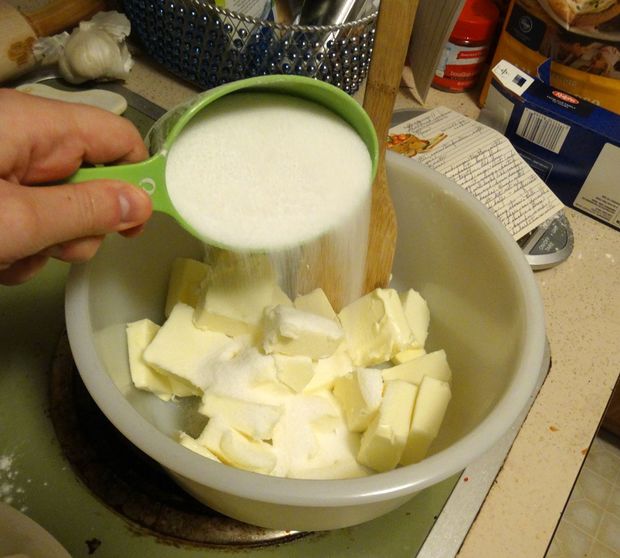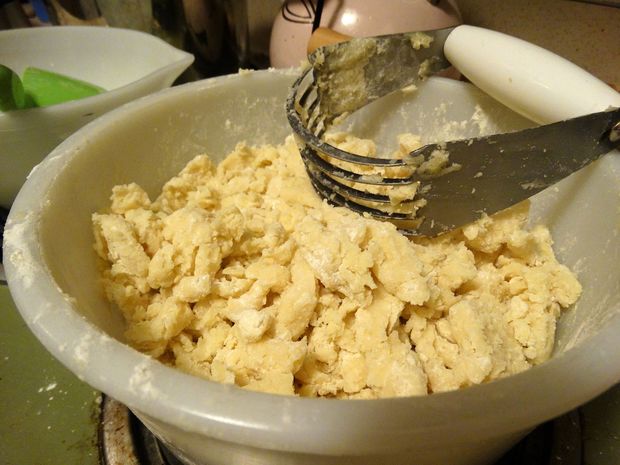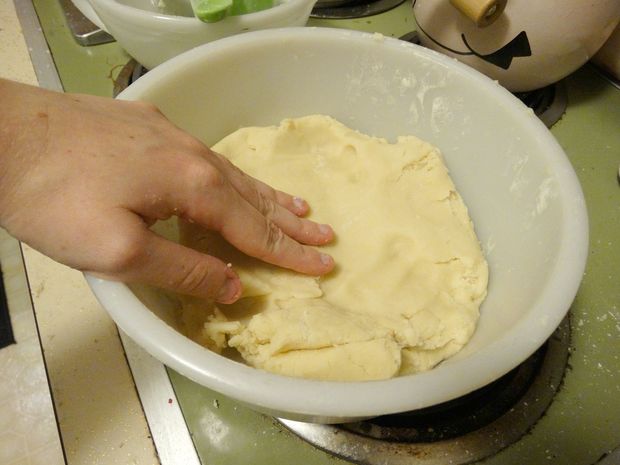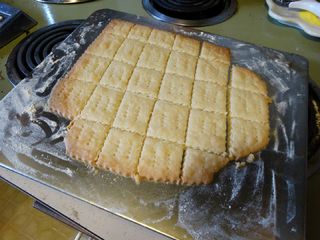Question ID: 4000-3947-2-3-4-6
Recipe Description
1 lb Unsalted Butter --Yes, a whole pound (one box). Let it sit out on the counter to soften, to make it easier to cream later.1 Cup Sugar1/2 tsp Salt4 Cups FlourTools:2 large bowlsMeasuring cup and spoonsBaking stone or baking sheetWooden SpoonPastry Blender --You can blend the ingredients with a traditional mixing spoon if you don't have this, but a pastry blender definitely makes it easier to distribute ingredients evenly.Pastry Crimper --I highly recommend this one from Betty Crocker because you get a cutting edge and crimping edge on one tool.Whisk --optional, but I think this is great for blending the dry ingredients with the least mess.ForkSpatulaBrown Paper --for cooling/ absorbing excess grease.
In one large bowl, measure 4 Cups flour. *Remember: a cup of flour should be loose and leveled off, not packed tight.Next, measure 1/2 teaspoon salt.Add the salt to the bowl of flour.Use a whisk to sift the ingredients together. I like using a whisk instead of a mixing spoon because the granules can flow freely between the wires, helping with even distribution and reducing the risk of flinging flour out of the bowl.
Unwrap a softened stick of butter and place it in your second mixing bowl.I like to break up the butter into thick slices with a wooden spoon, to make it a little more manageable when creaming.Repeat with the other 3 sticks of butter in the box for a total of 1 pound of butter.Measure 1 Cup Sugar.Add the sugar to your butter bowl and use the wooden spoon to mash and fold the sugar in. Work until you have a thick, chunky paste with sugar distributed evenly throughout.
Next you'll combine all your ingredients into one bowl. Add 1 cup flour to your butter bowl, then use a pastry blender to work it into the creamed sugar. If you've never used a pastry blender before, it is sort of like a potato masher. Just grip and press downward, letting the dough be worked through the blades. You may need to clear the blades with your mixing spoon once in a while as your dough gets thicker.Continue to add flour to the butter bowl one cup at a time, blending between portions.When you're finished, you should have a chunky dough that resembles cornmeal. Ingredients should be blended thoroughly and it will be moist, but not greasy.
Use clean hands to knead the dough together, eliminating the chunky texture.If working in small batches, as suggested, break off 1/3 - 1/2 of the dough to work with. Wrap the rest of the dough in cling wrap and place in the fridge for up to a week.
Lightly flour your baking sheet or baking stone.Place the ball of dough you're working with on the sheet.Roll out flat, until dough is about 1/4 inch thick, flouring your dough and rolling pin as needed to prevent sticking and tearing.As you bring the dough to the edges of the sheet, you'll realize the circular form is going to leave you with some odd shaped end cookies. If you want to avoid these for presentation's sake, use the cutting head of the pastry crimper to skor away excess. This extra dough can be added back to your dough ball in the fridge for use in a later batch.Next, use the crimping blade to run lines down the length of your dough. The distance between lines should be no less than 1 inch, as sections smaller than this are more prone to burn.Now run the crimper perpendicular to your first set of lines, creating a grid. These are your final cookie sizes.Lastly, use a regular table fork to poke 2-3 rows of holes in each cookie. These holes prevent dough bubbling and promote a more even bake.
The original recipe calls for the oven to be heated to 350 degrees, then reduced to 325 before the cookies are put in for 20-30 minutes. It pays to know your oven!Ours is 50yrs old and tends to run about 25 degrees too hot. Since these cookies are thin, I dialed back a little from the original recipe to prevent burned edges. Adjust accordingly to your oven's tendencies and always set the timer for the minimum of 20 minutes. You can always leave them another 5-10, but you can't undo burning!Watch for the edges to turn golden. You'll be able to smell when they're ready to come out! If your crimped edges melded back together in the oven, a quick run of the crimper while your cookies are still hot will separate them easily.Let cool on the baking sheet for 5 minutes before transferring to brown paper for another 10-15.
Line a tupperware container with paper towel for storage. You can also dress up a ziploc with a nice bow for a travel ready host/ hostess gift.To re-invigorate that dough ball in the fridge, simply unwrap from the plastic and zap in the microwave for the 30 seconds to soften. Knead and you're ready to go on another batch.Happy snacking and a buttery new year!
Question & Answer
Question: What is the correct order of the images?
Choices:
    |
| (A) |
    |
| (B) |
    |
| (C) |
    |
| (D) |
    |
|---|
 (A) (A) |